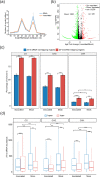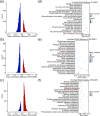Dynamic changes in transposable element and gene methylation in mulberry (Morus notabilis) in response to Botrytis cinerea
- PMID: 34193838
- PMCID: PMC8245511
- DOI: 10.1038/s41438-021-00588-x
Dynamic changes in transposable element and gene methylation in mulberry (Morus notabilis) in response to Botrytis cinerea
Abstract
DNA methylation has been proposed to regulate plant stress resistance. However, the dynamic changes in DNA methylation in woody plants and their correlations with pathogenic responses are not fully understood. Here, we present single-base maps of the DNA methylomes of mulberry (Morus notabilis) leaves that were subjected to a mock treatment or inoculation with Botrytis cinerea. Compared with the former, the latter showed decreased mCG and mCHG levels and increased mCHH levels. DNA methylation inhibitors reduced resistance gene methylation levels and enhanced mulberry resistance, suggesting that the hypomethylation of resistance genes affects mulberry resistance to B. cinerea. Virus-induced gene silencing of MnMET1 enhanced the expression of mulberry-resistance genes, thereby increasing the plant's resistance to B. cinerea. We also found that MITEs play a dominant role in controlling DNA methylation levels. MITEs appear to be the main sources of 24-nt siRNAs that regulate gene expression through the RNA-directed DNA methylation pathway.
Conflict of interest statement
The authors declare no competing interests.
Figures








Similar articles
-
MnASI1 Mediates Resistance to Botrytis cinerea in Mulberry (Morus notabilis).Int J Mol Sci. 2022 Nov 2;23(21):13372. doi: 10.3390/ijms232113372. Int J Mol Sci. 2022. PMID: 36362160 Free PMC article.
-
Mulberry MnGolS2 Mediates Resistance to Botrytis cinerea on Transgenic Plants.Genes (Basel). 2023 Oct 6;14(10):1912. doi: 10.3390/genes14101912. Genes (Basel). 2023. PMID: 37895261 Free PMC article.
-
Characterization of the Chitinase Gene Family in Mulberry (Morus notabilis) and MnChi18 Involved in Resistance to Botrytis cinerea.Genes (Basel). 2021 Dec 31;13(1):98. doi: 10.3390/genes13010098. Genes (Basel). 2021. PMID: 35052438 Free PMC article.
-
Mulberry genes MnANR and MnLAR confer transgenic plants with resistance to Botrytis cinerea.Plant Sci. 2020 Jul;296:110473. doi: 10.1016/j.plantsci.2020.110473. Epub 2020 Mar 19. Plant Sci. 2020. PMID: 32540003
-
A Novel LncRNA, MuLnc1, Associated With Environmental Stress in Mulberry (Morus multicaulis).Front Plant Sci. 2018 May 29;9:669. doi: 10.3389/fpls.2018.00669. eCollection 2018. Front Plant Sci. 2018. PMID: 29896205 Free PMC article.
Cited by
-
MnASI1 Mediates Resistance to Botrytis cinerea in Mulberry (Morus notabilis).Int J Mol Sci. 2022 Nov 2;23(21):13372. doi: 10.3390/ijms232113372. Int J Mol Sci. 2022. PMID: 36362160 Free PMC article.
-
The pivotal ripening gene SlDML2 participates in regulating disease resistance in tomato.Plant Biotechnol J. 2023 Nov;21(11):2291-2306. doi: 10.1111/pbi.14130. Epub 2023 Jul 19. Plant Biotechnol J. 2023. PMID: 37466912 Free PMC article.
-
Identification of Putative Markers of Non-infectious Bud Failure in Almond [Prunus dulcis (Mill.) D.A. Webb] Through Genome Wide DNA Methylation Profiling and Gene Expression Analysis in an Almond × Peach Hybrid Population.Front Plant Sci. 2022 Feb 14;13:804145. doi: 10.3389/fpls.2022.804145. eCollection 2022. Front Plant Sci. 2022. PMID: 35237284 Free PMC article.
-
Epigenetic weapons of plants against fungal pathogens.BMC Plant Biol. 2024 Mar 6;24(1):175. doi: 10.1186/s12870-024-04829-8. BMC Plant Biol. 2024. PMID: 38443788 Free PMC article. Review.
-
Mulberry MnGolS2 Mediates Resistance to Botrytis cinerea on Transgenic Plants.Genes (Basel). 2023 Oct 6;14(10):1912. doi: 10.3390/genes14101912. Genes (Basel). 2023. PMID: 37895261 Free PMC article.
References
LinkOut - more resources
Full Text Sources
Research Materials

